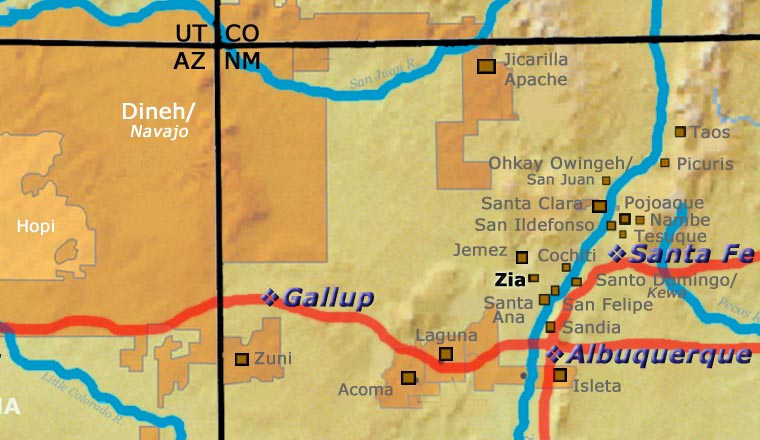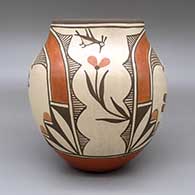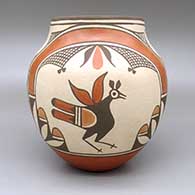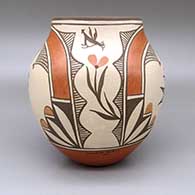
Elizabeth Medina
Zia

Elizabeth was born into the Toya family of Jemez Pueblo in 1956 and grew up surrounded by some of the finest Jemez Pueblo potters. She made Jemez-style pottery herself until she married Marcellus Medina of Zia Pueblo in 1978. Then she moved to Zia and received permission from the Zia elders to make pottery in the Zia style. She learned Zia styles from her mother-in-law, Sofia Medina. Because she has been at Zia Pueblo and has made pottery in the Zia style most of her adult life, she is referenced as a Zia potter. Today Elizabeth is probably the finest of all working Zia potters.
Elizabeth's pieces are all hand-coiled and shaped, painted with native clays and ground fired in the traditional way. She also often collaborates with her husband, Marcellus.
Some Awards Won by Elizabeth
- 2019 Santa Fe Indian Market: Pueblo Pottery Excellence Award shared with Marcellus Medina. For creative excellence in the use of traditional materials and Native techniques and designs in Pueblo pottery
- 2019 Santa Fe Indian Market, Classification II - Pottery, Division B - Traditional Painted Pottery, Category 604 - Painted polychrome pottery in the style of Jemez, Zia, Santa Ana, Sandia, San Felipe, Isleta, any form: First Place shared with Marcellus Medina
- 2000 Santa Fe Indian Market, Classification II, Division E - Traditional pottery, jars with painted designs on matte or semi-matte surface, Category 1206 - Jars, Zia, Santa Ana, Santo Domingo or Cochiti: First Place
- 1999 Santa Fe Indian Market, Classification II - Pottery, Division E - Traditional pottery, jars with painted designs on matte or semi-matte surface: Best of Division shared with Marcellus Medina
- 1999 Santa Fe Indian Market, Classification II - Pottery, Division E - Traditional pottery, jars with painted designs on matte or semi-matte surface, Category 1206 - Jars, Zia, Santa Ana, Santo Domingo or Cochiti: First Place shared with Marcellus Medina
- 1999 Santa Fe Indian Market, Classification II - Pottery, Division E - Traditional pottery, jars with painted designs on matte or semi-matte surface, Category 1206 - Jars, Zia, Santa Ana, Santo Domingo or Cochiti: Third Place
- 1998 Santa Fe Indian Market, Classification II - Pottery, Division E - Traditional pottery, jars, painted designs on matte or semi-matte surface, Category 1206 - Jars, Zia, Santa Ana, Santo Domingo or Cochiti: Third Place
- 1998 Santa Fe Indian Market, Classification II - Pottery, Division E - Traditional pottery, jars, painted designs on matte or semi-matte surface, Category 1206 - Jars, Zia, Santa Ana, Santo Domingo or Cochiti: Honorable Mention with Marcellus Medina
- 1993 Santa Fe Indian Market, Classification II - Pottery, Division F - Traditional pottery, painted designs on matte or semi-matte surface, jars, Category 1303 - Jars, Zia, Santa Ana, Santo Domingo or Cochiti: Second Place
- 1992 Santa Fe Indian Market, Classification II - Pottery, Division F - Traditional pottery, painted designs on matte or semi-matte surface, jars, Category 1303 - Jars, Zia, Santa Ana, Santo Domingo or Cochiti: First Place
- 1991 Santa Fe Indian Market, Classification II - Pottery, Division F - Traditional pottery, painted designs on matte or semi-matte surface, jars, Category 1303 - Jars, Zia, Santa Ana, Santo Domingo or Cochiti: Second Place
- 1991 Santa Fe Indian Market, Classification II - Pottery, Division G - Traditional pottery, painted designs on matte or semi-matte surface, all forms but jars, Category 1404 - Other bowl forms, over 8 inches in diameter: Third Place
- 1986 Santa Fe Indian Market: Wounded Knee Award - Best traditional pottery bowl or jar 15" or more in height or diameter
- 1986 Santa Fe Indian Market, Classification II - Pottery, Division F - Traditional pottery, painted designs on matte or semi-matte surface, jars, Category 1203 - Jars, Zia, Santa Ana, Santo Domingo or Cochiti: Third Place
- 1983 Santa Fe Indian Market, Classification II - Pottery, Division F - Traditional, painted designs on matte or semi-matte surface: First Place
100 West San Francisco Street, Santa Fe, New Mexico 87501
(505) 986-1234 - www.andreafisherpottery.com - All Rights Reserved

Zia Pueblo
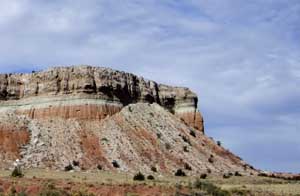
A typical view on the Zia Reservation
Zia Pueblo is situated in the Jemez Mountains with Jemez Pueblo to the north and Santa Ana Pueblo to the south. Despite its picture postcard setting, Zia's history for the last four hundred years has been difficult.
Antonio de Espejo led a small troop of Spanish explorers up the Jemez River and discovered Zia Pueblo in 1583. Espejo estimated there were about 4,000 inhabitants in a city of house blocks up to three and four stories high with five major plazas and many smaller ones. "The people are clean. The women wear a blanket over their shoulders tied with a sash at their waist - their hair cut in front, and the rest plaited so that it forms two braids, and above a blanket of turkey feathers," is how Espejo's scribe recorded it.
Zia today is a water-poor community of about 800, most of whose residents work away from the pueblo.
The people of Zia participated in the Pueblo Revolt of 1680 and when Spanish troops returned in 1682 and 1687, the Zias were able to repulse them. When more Spanish troops returned in 1688 they were finally successful in conquering the Zias. The Spanish killed many people, burned the pueblo and took many slaves back to Mexico with them. When Don Diego de Vargas returned to northern Nuevo Mexico in 1692, the Zias sued for peace and accepted the rule of Spain almost immediately. However, the new Spanish government did little to protect the pueblos from the raids of nomadic Ute, Apache, Comanche and Navajo warriors. Zia fortunes slid in many ways and by the 1890's the tribe was down to just 98 members.
Today, the Pueblo of Zia numbers about 800 people, many of whom are active artists producing everything from pottery to jewelry to baskets to paintings, sculptures and wood carvings.
Pottery was a Zia mainstay for at least two hundred years. The balance of trade was food from Santa Ana, Jemez and San Felipe in return for pottery from Zia. Pottery still remains Zia's largest home-grown cash crop.
Zia pottery is Keresan and as such, shares design characteristics with other important Keresan pottery, especially Acoma and Laguna ware. They all have their favorite geometric patterns, stylized birds, rainbows and flowers, but each maintains its own individual images and colors.
Where Acoma and Laguna's bird is a parrot, Zia's is a roadrunner. Acoma's black and orange on stark white is contrasted by Zia's dark brown and brownish red on creamy white. Further, Acoma's hard, paper-thin, white clay ollas differ greatly from Zia's sturdy, slightly granular, basalt-tempered red clay jars. Because of their unique local clay and their traditional designs and shapes, Zia pottery is unique and easily distinguished from the pottery of other pueblos.
When New Mexico became a territory (and then a state), some of the symbols involved were sourced from Zia Pueblo. The roadrunner often pictured on Zia pottery became the official New Mexico state bird and the Zia sun symbol (a circle with four parallel lines in four groups pointing in the four directions) became a state symbol depicted in many places, including the state flag.
100 West San Francisco Street, Santa Fe, New Mexico 87501
(505) 986-1234 - www.andreafisherpottery.com - All Rights Reserved

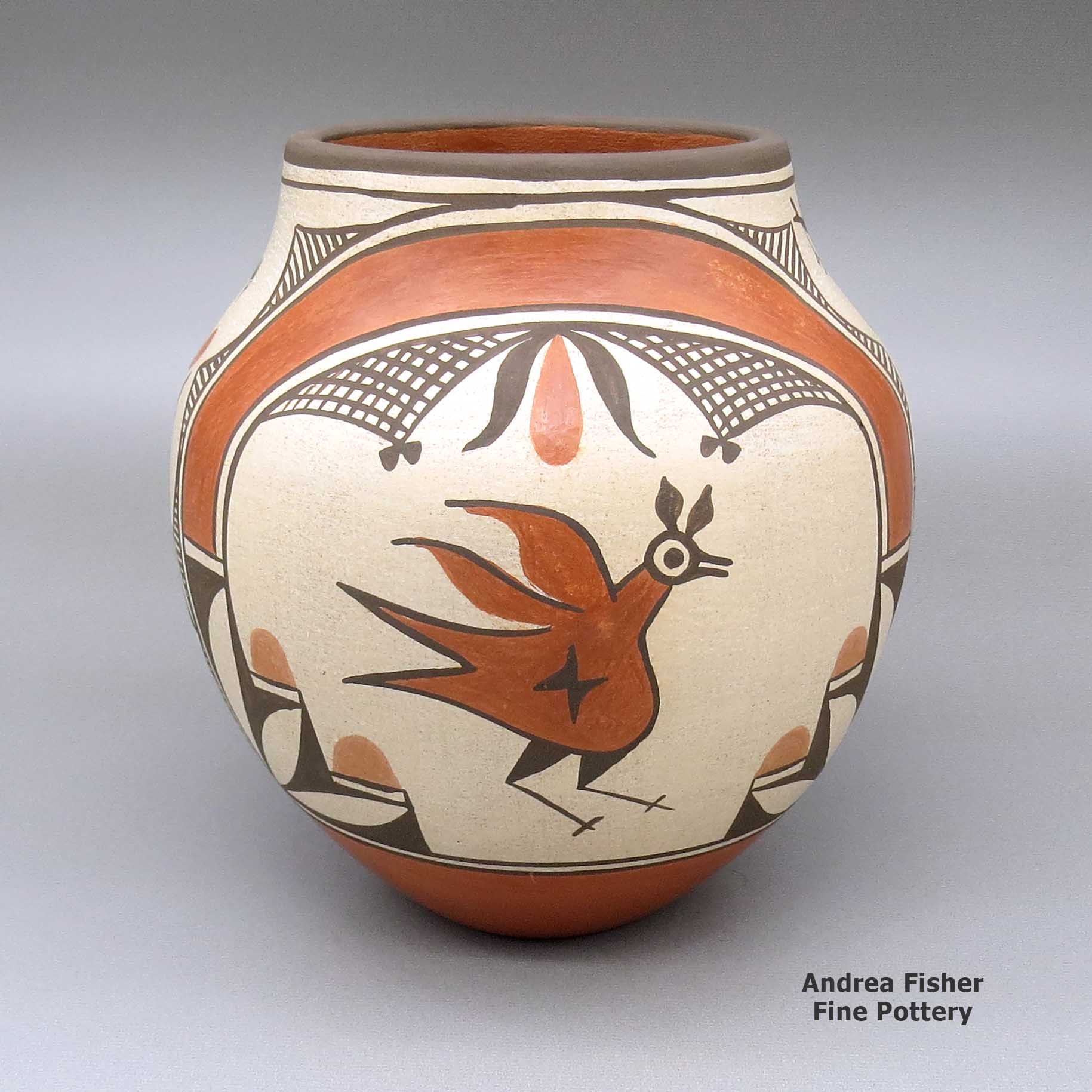
Elizabeth Medina, Zia, Polychromejarwithatwo-paneltraditionalZiadesignfeaturingroadrunner,flower,rainbow,hummingbird,fineline,andgeometricelements
Zia
$ 695
zzza4c203m2
Polychrome jar with a two-panel traditional Zia design featuring roadrunner, flower, rainbow, hummingbird, fine line, and geometric elements
7 in L by 7 in W by 7.5 in H
Condition: Excellent
Signature: Elizabeth Medina Zia
Date Created: 2024
100 West San Francisco Street, Santa Fe, New Mexico 87501
(505) 986-1234 - www.andreafisherpottery.com - All Rights Reserved

Medina Family Tree
Disclaimer: This "family tree" is a best effort on our part to determine who the potters are in this family and arrange them in a generational order. The general information available is questionable so we have tried to show each of these diagrams to living members of each family to get their input and approval, too. This diagram is subject to change should we get better info.
-
Rosalea Medina Toribio (c.1858-1950) & Mariano Toribio (c. 1854-c.1918)
- Juanita Toribio Pino (1890-1987) & Andres Pino (1885-1947)
- Sofia Medina (1932-2010) & Raphael Medina (1929-1998)
- Marcellus Medina (1954-) & Elizabeth Medina (1956-)
- Kimberly Medina (1973-)
- Marcella Medina (1974-)
- Edna Medina Galiford (1957-)
- Lois Medina (1959-2002)
- Rachel Medina Raton (1961-)(married into Santa Ana)
- Marcellus Medina (1954-) & Elizabeth Medina (1956-)
- Sofia Medina (1932-2010) & Raphael Medina (1929-1998)
- Andrea Toribio Gachupin (1896-1956) & Jose Gachupin (ca. 1890-1953)
- Gloria Gachupin Chinana (1940-)
- Helen Gachupin (1931-1992)
- Maria Bridgett (c. 1890-)
- Candelaria Gachupin (1908-) & Antonio Gachupin
- Dora Tse-Pe & Johnnie Tse-Pe Gonzales (San Ildefonso)
- Candace Tse-Pe
- Gerri Tse-Pe
- Irene Tse-Pe
- Dora Tse-Pe & Johnnie Tse-Pe Gonzales (San Ildefonso)
- Candelaria Gachupin (1908-) & Antonio Gachupin
- Trinidad Medina (c. 1890s-1965)(Antonio Gachupin's sister, aunt of Dora Tse Pe, grandmother of Rafael Medina and teacher of Sofia Medina)
Some of the above info is drawn from Southern Pueblo Pottery, 2000 Artist Biographies, by Gregory Schaaf, © 2002, Center for Indigenous Arts & Studies
Other info is derived from personal contacts with family members and through interminable searches of the Internet and cross-examination of the data found.
(505) 986-1234 - www.andreafisherpottery.com - All Rights Reserved
